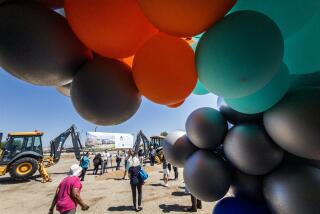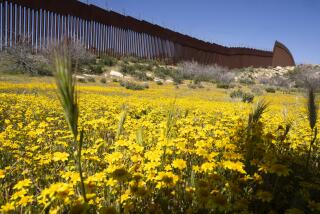Science / Medicine : Biosphere II : Prelude to Mars
- Share via
ORACLE, Ariz. — For five days in March, Abigail Alling lived in a room-sized greenhouse here completely sealed off from the external environment. The food she ate was grown in the module, the air she breathed was recycled by the plants and the water she drank and bathed in was purified by the soil.
The experiment, designed to test for the buildup of toxic gases, is believed to be the longest time that anyone has spent in a closed ecosystem where everything essential for life is recycled and regenerated. “By the time the five days were over, I hated to come out,” Alling said. “I really felt at one with the environment.”
But Alling and her 13 compatriots here at Sunspace Ranch are aiming at a much more ambitious goal. In September, 1990, eight of them will step into a much larger greenhouse now under construction and seal themselves off for two years, relying on the closed ecosystem to provide them with everything they need for life.
The $30-million, 2.5-acre structure, called Biosphere II, will contain nearly 4,000 species of plants and animals and seven different ecological habitats or biomes, including a tropical rain forest, a savanna, a marsh, an “ocean,” a desert, an intensive agriculture area and a human habitat.
At the moment, researchers at the Biosphere project are making modest design changes in the structure and agonizing over a number of decisions about what to put inside it. For example, should hummingbirds or bees be used to pollinate flowers, should goats or cows be used for milk, which eight of the 14 researchers should be chosen?
The eight “Biospherians” eventually selected will grow everything they eat; water and air will be recycled. The only things that will enter and leave Biosphere II (the Earth is Biosphere I) are sunlight, electrical energy, and electronic communications. For their leisure time, the Biospherians will have access to electronic newspapers, commercial television, cable TV, videotaped movies and other diversions.
The Biospherians see their effort as a kind of “dress rehearsal” for a two-year trip to Mars or for the establishment of a lunar colony. They hope to demonstrate that life can be sustained by a complex interaction of plants, animals and soil.
Equally important, the participants say, is what the project can teach about life on Earth. “There is kind of a war in Biosphere I between ecology and technology,” said UCLA pathologist Roy Wolford, one of the Biospherians. Biosphere II will show ways in which technology can be used to benefit the ecology rather than harm it, he said.
Already, for example, the team has developed new techniques for natural recycling and purification of air and water, control of plant pests and improvements in greenhouse systems, according to project director Margaret Augustine.
And after Biosphere II is completed, project spokeswoman Kathleen Dyhr sees a network of similar buildings in cities throughout the world, demonstration projects that, like zoos and arboretums, will serve to teach visitors about the complex interactions between plants and animals.
For now, though, the Biospherians are concentrating on getting Biosphere II constructed and choosing the species that will inhabit it. That is proving to be a massive task that already has the team more than a year behind its initial, now admittedly over-optimistic schedule.
Located in the Santa Catalina mountains on the edge of the Sonora Desert about 25 miles north of Tucson, Biosphere II is an unprecedented construction project that, because it must be completely sealed from the environment, requires unusual building techniques.
To begin with, the entire 2.5-acre floor of the building was covered with concrete. Over that was welded a layer of special stainless steel to keep water in and microorganisms out. The steel was then covered with another layer of concrete.
This spring, workers began installing the framework that will hold the building’s 6,400, 5 1/2-foot-square windows. The innovative frame, designed by Chatsworth architect Peter Pearce, is composed of 86,000 steel struts bolted together into high-strength triangles in much the same fashion that Tinkertoys are assembled.
In July, glazers began installing windows in the intensive agriculture section of Biosphere II. The windows are glazed with a special termite-resistant material to prevent leaks from developing. In tests of the material, Wolford said, termites “resorted to cannibalism” before eating the glazing compound.
The resistant glazing is necessary for Biosphere II to meet its goal of having only a 1% exchange of air with the outside atmosphere every year. By contrast, a tightly sealed office building exchanges 20% of its air every day.
By this fall, that section will have been filled with 5,000 cubic yards of soil and partially closed off so that the Biospherians can begin growing crops in it, preparing the way for their eventual occupation.
Meanwhile, workers will be enclosing the other six habitats, filling the 1-million-gallon “ocean,” planting trees, checking air circulation patterns and installing electronic sensors to measure temperatures, pollutants and other important characteristics--finishing the thousand-and-one different tasks necessary to mimic the complex ecology of the real world.
When it is finished, Biosphere II will have a volume of 5 million cubic feet, about half the volume of the Great Western Forum in Inglewood. Two expanding “lungs” connected to it through six-foot-tall tunnels will have a potential capacity of an additional 2 million cubic feet.
As construction has continued, the design has undergone several changes from the original conception. The most important involves an innovative system of electronically controlled louvers that were meant to shield the facility from the bright Arizona sunlight during the hottest part of the day, thereby holding down temperatures inside.
Studies in the test module occupied by Alling showed that the louvers did not let enough sunlight in for plants to grow adequately, and they have been removed from the design. Cooling ponds outside the facility will be used to dissipate excess heat.
Biosphere II was also designed to be powered with electricity from solar panels mounted on the man-made berm surrounding the facility. The cells proved to be too expensive, however, and the facility will now be powered by natural gas.
The biggest change inside Biosphere II involves a decision not to use hydroponics--a soil-free growing system in which the roots of plants are sprayed with a mist of nutrient-containing water--in the intensive agriculture biome.
Tests have shown that it would be too difficult inside Biosphere II to replenish the nutrients in the water used for hydroponics. Growing the plants in soil accomplishes this feat much more cheaply and easily, Wolford said.
The Biospherians are also making a number of changes in the animals and insects that will be included in the project. The group had originally feared that bees could not be used to pollinate many plants because previous research by others seemed to indicate that the glass windows would screen out ultraviolet light that the bees require for navigation.
The researchers had planned to use hummingbirds instead, even though they would be less effective pollinators than the bees and each pair would require the nectar from 3,200 flowers per day.
Recent experiments in the test module, however, have shown that the bees probably can navigate well enough to serve their purpose.
The group also had to abandon plans to use barred rock hens in Biosphere II. During preliminary studies, Dyhr said, “the roosters lost interest in the hens, and the hens stopped laying eggs.” Apparently, conditions in Arizona are too hot for the birds. The researchers are now studying a chicken that was produced by crossbreeding jungle fowl with Japanese bantam chickens.
They are also reconsidering their decision to use African pygmy goats instead of cows for dairy products and are now studying several breeds of dwarf cows. Virtually all the animals in the project, in fact, will be pygmy species because they consume less food, and walking through the greenhouses and viewing all the miniature species gives one the distinct impression of what it must be like to be a giant.
The African pygmy goats, Dyhr said, have “the most superb, delicious” milk and can be milked for two years after a pregnancy, twice as long as a cow. But “goats are browsers,” she said. “How long can they be happy in one place?”
Right now, she added, Biosphere II’s animal experts are searching for a “mystical small Asian cow” that they have heard would meet their requirements, but which they have not been able to locate.
Dozens of scientists from such well-respected institutions as the Smithsonian Institution in Washington, the University of Arizona, the New York Botanical Garden, the Bishop Museum in Hawaii and Kew Gardens in Britain have participated in choosing the species to be included.
The four male and four female human occupants of Biosphere II will probably not be selected until shortly before the experiment begins, according to Augustine, and the criteria that will be used are not being announced.
One obvious criterion, however, will be the ability of a candidate to handle many different jobs within the complex, ranging from farming to maintenance to operation of a computer. They are even learning some medicine and dentistry.
The Biospherians will spend about four hours each day on maintenance, half or more of that in the intensive agriculture section. The rest of the day will be devoted to various scientific experiments. “The challenge is to design it so that we don’t work everyone to death,” according to biologist Carl N. Hodges of the University of Arizona, who is the primary scientific contractor for the project.
The Biospherians will have a much more diverse diet than Alling did during her five-day stay. Because of space limitations in the test module, she did not have access to fish, chickens or goats and subsisted on 29 fruits and vegetables, including potatoes, beans, carrots, strawberries and papayas.
The test was undertaken because Soviet experiments in closed environments, which did not involve recycling, had shown a gradual buildup of potentially toxic gases--including hydrogen sulfide, ethylene and ammonia--from the breakdown of organic materials.
But sensitive monitors inside Alling’s test module showed no such buildup over the test period, indicating that this should not be a problem when Biosphere II itself is closed. “We would have to say the test was a complete success,” Wolford said.






